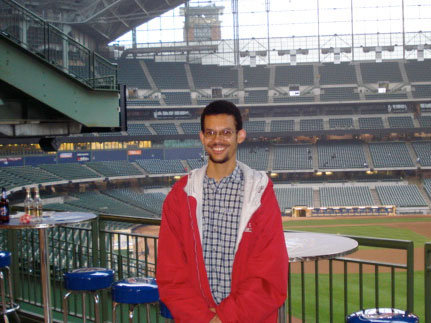On Nov. 9, 1996, hundreds of baseball fans braved blustery temperatures to attend the ceremonial groundbreaking at the site now known as Miller Park.
Tim Kaebisch, then 10 years old, was standing in the crowd when the silver-plated shovels hit the dirt. As a fan of architecture, he returned to the site often as construction progressed.
"I'd always been interested in buildings," Kaebisch said. "I took bi-weekly tours around the exterior of the building during the construction process."
Kaebisch was fascinated with the design of the retractable roof. In 2001, at roughly the same time Miller Park opened for business (and baseball), Kaebisch decided to combine his interest in the ballpark with another lifelong hobby: building things with Legos.
"Most of my childhood, I was making small cities with Legos, as opposed to just buildings," said Kaebisch, who turns 22 this month and studyies environmental architectural engineering at Milwaukee School of Engineering.
"As I was getting into high school (at Rufus King), I decided I wanted to try to make a building that had a function to it, as opposed to one that just sat there.
"Miller Park, since I was really involved with that, seemed like a good project to start on. That's how I got started."
Kaebisch's goal, to make a working Lego model of Miller Park, didn't get off to a strong start. Without access to actual blueprints, he based his designs on photos he had taken during the construction phase and others he saw online.
"I took a few tours of the building that allowed me to get into places that I usually couldn't see," he said.
Another problem was finding materials.
"When I started that first version, I built the roof on it and figured out that I didn't have enough pieces," he said. "So, I went back to making cities for awhile. But, than I revisited it and began to order some more blocks and I finally got something that worked.
"Even though it was just a basic skeleton and the roof, I just kept building on it."
Gradually, the model next to his bed began to take shape.
"I would work on it for awhile, then like it kind of sit there for a few months and make another upgrade," Kaebisch said. "It took me a few trials to get the roof to work. I just kept elaborating on it to make it more realistic.
"The most difficult part was getting the roof to work. I think it took me about a month to figure out how to get it all geared right with the Lego motors. I was trying to keep everything Lego and not buy special motors that had nothing to do with it."
Kaebisch would work on the project on weekends and during breaks from school, but he is unable to make a -- pardon the pun -- ballpark estimate of how much time he invested in the project.
"It was quite a bit of time," he said. "I don't really have accurate records of how much. But, it was quite a bit. Basically did most of my upgrades during the summer or during spring break or winter break."
Kaebisch started his Lego fixation at age 5. A few years ago, Kaebisch got into model trains, as well. He is currently the president of MSOE's Society of Model Engineers, and displayed his Miller Park model at the club's Train Time event last weekend.
Kaebisch isn't certain what the future holds for the model. Once in awhile, students will see a photo of it on his computer desktop and ask questions, but generally speaking few of his classmates know of his project and he doesn't have plans to parlay it into an extra-credit project.
"There isn't really a course that I could related it to for credit," he said. "I keep wanting to write an essay or something about it, but that hasn't come up. They're pretty strict about their essay topics."
A trip to Legoland, the Lego theme park in California, isn't out of the question and Kaebisch may also talk to the Brewers about having the model displayed at Miller Park during the season. Right now, though, he's too busy with class work, trains and the occasional game of chess to spend too much time worrying about how to "cash in" on the Miller Park model.
"It's something I originally did for me," he said. "It took a long time, but I had a lot of fun with it."
Host of “The Drew Olson Show,” which airs 1-3 p.m. weekdays on The Big 902. Sidekick on “The Mike Heller Show,” airing weekdays on The Big 920 and a statewide network including stations in Madison, Appleton and Wausau. Co-author of Bill Schroeder’s “If These Walls Could Talk: Milwaukee Brewers” on Triumph Books. Co-host of “Big 12 Sports Saturday,” which airs Saturdays during football season on WISN-12. Former senior editor at OnMilwaukee.com. Former reporter at the Milwaukee Journal Sentinel.




